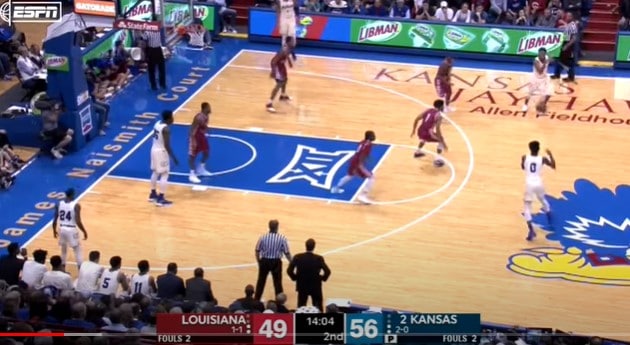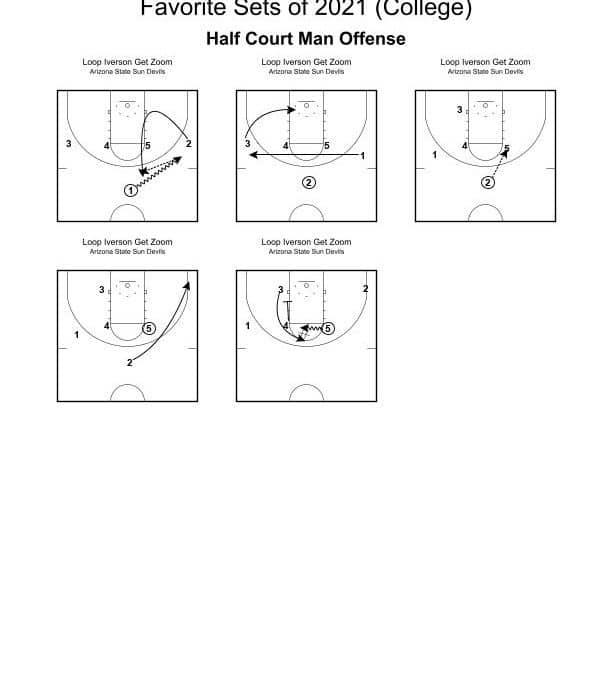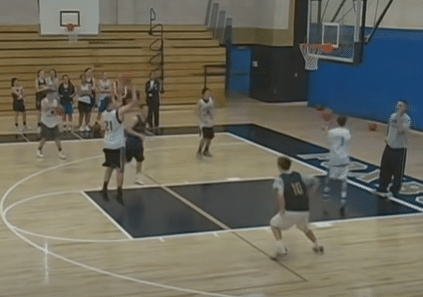14 Options for the Transition Game by Blaine Taylor
3 Phases to Transition Game
1. Outlet Phase
2. Acceleration Phase
3. Decision Phase
Use a single-guard outlet so other players can fly down-court
Trigger man – Player who rebounds and makes outlet pass, or player who inbounds a make to outlet.
Outlet guard stays in the middle and looks to receive outlet pass to either side of the court.
Rebounder turns to the outside of the court – pivots outside, not inside, so outlet guard must get to the rebound side to receive outlet pass – so the outlet guard must read the rebounder and get to that side for outlet pass.
Outlet pass should be made to the outside of the outlet guard’s body (throwing to the outside of the floor). If the pass goes inside and lead the guard to turn inside, vulnerable to steal, travel, or charge. Passing to the outside is safer.
2 and 3 flies down the floor and look for long pass.
First thing we want to do on outlet is to establish a side of the floor, and then look at ONE PASS OPTIONS. Teach it right side and teach it left side.
Outlet guard takes one dribble and then looks to see if “wing away” (3 man) is open for long pass – float the pass out in front of him and have him run under pass.
First option: Wing Away Lay-up
Second option: Ball-side wing for three-point shot
Third option: Rim runner at rim
Fourth option: “Solo” – Outlet guard on dribble penetration trying to make an individual play – use this option once we get court “stretched, widened, and sliced”
Fifth option – Trail
OUTLET OPTIONS (one-pass) | 14 Options for the Transition Game by Blaine Taylor
• Wing
• Three
• Rim
• Solo
• Trail
Another option – Don’t have trail stop, but continue through and run down to set crack-down screen for the 3. The problem with this is that you are now double low, which allows for post help and also restricts dribble penetration from point guard.
If we put in too many secondary options, we lose our push up the floor and opportunity to make plays. In transition basketball need to be able to attack the basket.
Passing the ball to the outside on outlet gives good angles for wing-away pass and for rim runner.
As outlet guard receives outlet pass, he should attack jump circle as we don’t want defense to know we are attacking right side all the time. That will give outlet guard a good angle to read pass to wing for three-point shot.
We feel good about the three-point shot from the wing on the break because we have great rebounding coverage with rim runner and wing away. Very difficult to block out in transition.
This three-point attempt comes after we look for layups, but part of the percentage of that shot is that we are going to get offensive rebounds.
Pass to rim-runner (option 3) needs to be lofted toward the rim so rim runner can run under pass and make plays.
Must be able to run the break to both the right and left side – the wings must adjust to which side we are attacking. If PG is running to the left side, that wing becomes the spot-up (Three) and the other wing attacks rim (Wing Away).
As you teach the sequence, go all right side and then all left side.
Run Cycles – Run all five shots in 30-35 seconds. Must finish each shot before you transition to the next shot.
FRONT COURT OPTIONS – Ball does not get passed ahead but PG brings ball into front court on the dribble. Options are Three, Rim, Trail, Solo – fifth option is PG penetrate (“punch to the paint”) and kick out to the Wing Away who steps out from block after not receiving pass ahead.
Run the Front Court Options as 5-on-0 Cycles as well | 14 Options for the Transition Game by Blaine Taylor
PG should run his full-court moves (hesitation, crossover, etc.) as he is bringing ball into front court.
On the pass to the wing for the three-point shot (Three) in Front Court options, PG is looking to punch the gap and then kick to the wing for the shot.
We play power basketball. We look to play inside-out, and really work to get the ball in to our post off the break. We shoot 18-20 threes a game, but that is predicated by what happens in the post not by coming down and just launching shots. We are going to read the defense inside-out, so that is why we work on these front court options.
TWO-PASS OPTIONS | 14 Options for the Transition Game by Blaine Taylor
1. Wing – Trail – In (1-2-5-4)
Rule: If defender is playing behind the post on pass to wing, wing must throw the
ball in to the post
If post is fronted, wing skips to trail (5), post (4) reverse seals and receives high-
low pass from trail (5)
2. Wing – Skip – In (1-2-3-4) | 14 Options for the Transition Game by Blaine Taylor
Post players need to do a good job of “Working the U” – moving there feet in U-pattern to take up space, keep defender on hip, and reverse seal on skip passes.
3. PG drag – feed the post | 14 Options for the Transition Game by Blaine Taylor
If defense sits on ball-side triangle (PG-wing-post), the PG keeps his dribble and dribbles through the free-throw circle while the post reverse seals just like on the skip, and looks fpr the high-low pass coming from the PG.
At the end of the break, we can just go into 4-out passing game.
4. Pass Advance – Wave Downscreen(Secondary action) | 14 Options for the Transition Game by Blaine Taylor
1 pass ahead to 2, 2 looks in to 4 cutting to block, 1 cuts to opposite block.
5 has two options on trail – screen down or ball-screen for 2.
4 has a two-count rule – count to 2 in post, if no post feed turn and screen across under basket. 3 runs off staggered double by 1 and 4 to ball side corner, then 1 runs off 5 down-screen to top of key. 4 rolls back to ball side block after 3 comes off his screen. 5 holds at the opposite block.
2 can pass to 3 in corner, 4 coming back to post (3-man triangle with 2,3, and 4), or 1 coming off 5 down screen.
If 2 passes to 1 and 1 doesn’t have shot, 5 can either post for 1 dribble over and post feed, or 5 can step out and look to catch a pass to 1 for a face-up move.
2 screen for 3, 4 step out to fill top and we are into Buccaneer.
5. Pass Advance – Wave On-Ball screen | 14 Options for the Transition Game by Blaine Taylor
Same initial action – 1 pass to 2, 4 post, 1 cut to opposite block, but now 5 will ball-screen for 2. 4 again turns to screen in lane, along with 1, for 3 who cuts to the ball-side corner.
2 attacks free-throw lane off 5’s ball-screen. 5 then continues down to set another screen for 3 in the block area. 3 is receiving a triple screen (1-3-5).
2 looks for shot coming off ball-screen, 3 coming off triple screen for shot, or 1 stepping out of his screen to the wing. 4 continues to the block for two-man game with 1 if 2 passes to 1. If 2 passes to 3, 3 looks shot or looks for two-man game with 5 posting up.
4-out spacing out of Wave creates space for guys to make plays, and it moves us nicely into our half-court offense.
Can also run Wave without pass advance to 2. 1 can dribble over to the wing and bump 2 through to the opposite block. All other movement is the same with 1 and 2 just exchanging spots.
Run Wave to both sides of the floor.
SPECIAL PLAYS | 14 Options for the Transition Game by Blaine Taylor
1. 1-4 High set (Wave out of half-court set) | 14 Options for the Transition Game by Blaine Taylor
Run just like Pass Advance Wave with all same options AND if 2 is denied out of 1-4 set, 1 can dribble over and bump 2 through to opposite block just like Wave with Dribble Over.
2. Twenty Cut – Same side | 14 Options for the Transition Game by Blaine Taylor
Run regular break with pass to trail (5), and then run “Twenty Cut” – 2 runs over the top of a backscreen by 4, 1 fades out to the wing.
If 2 is not open on his cut, 5 passes back to 1, 4 posts, and 5 and 3 set a double screen for 2. 2 looks for shot off pass from 1. If not shot 3 steps out, 5 ducks in looking for high-low from 2, and then into passing game.
Should be able to get a 3-point shot for 2 off the break in about 6-7 seconds.
3. Twenty-Cut – Reverse side
1 pass to 5, 4 screen for 2 for the “twenty cut”, 1 fade to wing – now 5 reverses ball to 3.
Now, 4 re-screens for 2 and then steps to ball-side post, 5 and 1 set double screen for 2.
Should be able to run these options in 5-10 seconds.
Do a lot of situational clock work in practice.
4. Quick (1-2-2 set)
1 dribbles to a wing, wings who are set up on blocks set a double back-pick for the weakside post (posts are set up at elbows). 2 and 3 set up shoulder to shoulder on back-pick. 5 rolls baseline side to ball-side block. Ball-side post (4 positioned at the elbow) screens for the 2 (screen-the-screener). 1 looks for 5 in the post and then passes to 2, who looks for shot coming off 4’s screen. If 2 doesn’t have shot, he looks to pass to either wing.
Also run “Quick” in transition.
With Quick, you have a side cleared for 1, so give your point guard an opportunity to make a penetration play while screens are taking place on weak-side.
5. Five-Up
5 sets trail ball-screen for 1 at the top of the key. 1 turns corner and 5 rolls to basket. As 1 is turning corner and 5 rolls, 4 is popping out from block. So, 1 has drive, pass to 5 on roll, and pass to 4 stepping out for jump shot, or kick to 2 or 3 spotting up. If 4 gets pass from 1, 4 looks for jump shot and then high-low pass to 5 in lane. 2 and 3 widen out at wings to clear middle.
6. Four-Up
Same action as Five-Up, but now off break the FIRST post down the floor is stopping in FT circle and setting ball screen for 1. 1 is attacking middle off ball-screen, 4 is rolling to basket, and 5 is trailing opposite to spot up for jump shot.
7. X (Run off break or half-court out of 1-4 high set)
2 runs off a baseline triple-screen set by 4, 3, and 5. 4 will then roll back into middle of lane and set screen for 3 who cuts out to opposite wing. 1 passes to 2 coming off triple screen or 3 coming out other side off single screen. After screening, 4 and 5 then post up at block on each side of floor.
If running X off break, 1 needs to look at break options first to give other players a chance to get into their screens.
SIDE OOB PLAY – Triangle | 14 Options for the Transition Game by Blaine Taylor
3 inbounds, 1 lines up near jump circle, 2 at opposite block, 4 at ball-side block, and 5 at top of key.
Triangle-One (Single screen) – 2 back picks for 5 looking for lob. 4 is stepping out of post to clear lane, 2 then steps out after the back-screen to get inbound. 2 looks to catch-face-and shoot or drive. On drive, 2 has 4 and 5 on either side of lane for dump off. 1 steps in to backcourt, and then back towards ball. 1 may get inbound pass from 3 and then drive to basket or pull up for jump shot.
Triangle-Two (Double screen) – 4 and 5 double screen for 2. 2 can go any way he wants – pinch, high, or low – and then posts are going to run off 2. 4 goes to block, 5 goes to high post.
Triangle-Three (Screen-the-screener) – 2 sets up at top of key and 5 sets up at opposite block. Steps out and then back screens for 2. 2 cuts outside 3-point line looking for shot. 5 then back-picks for 4 who cuts to the basket for the lob. 5 steps out after setting back-screen and looks for 3-point spot up. 1 is always an option to catch inbound pass and drive.
Reasons for Fast Break | 14 Options for the Transition Game by Blaine Taylor
1. Catch-Up Offense
2. Keeps Pressure Off
3. Diminishes to the Glass
4. Creates Worry
Click on the pdf link to download the basketball coaching clinic notes:




0 Comments